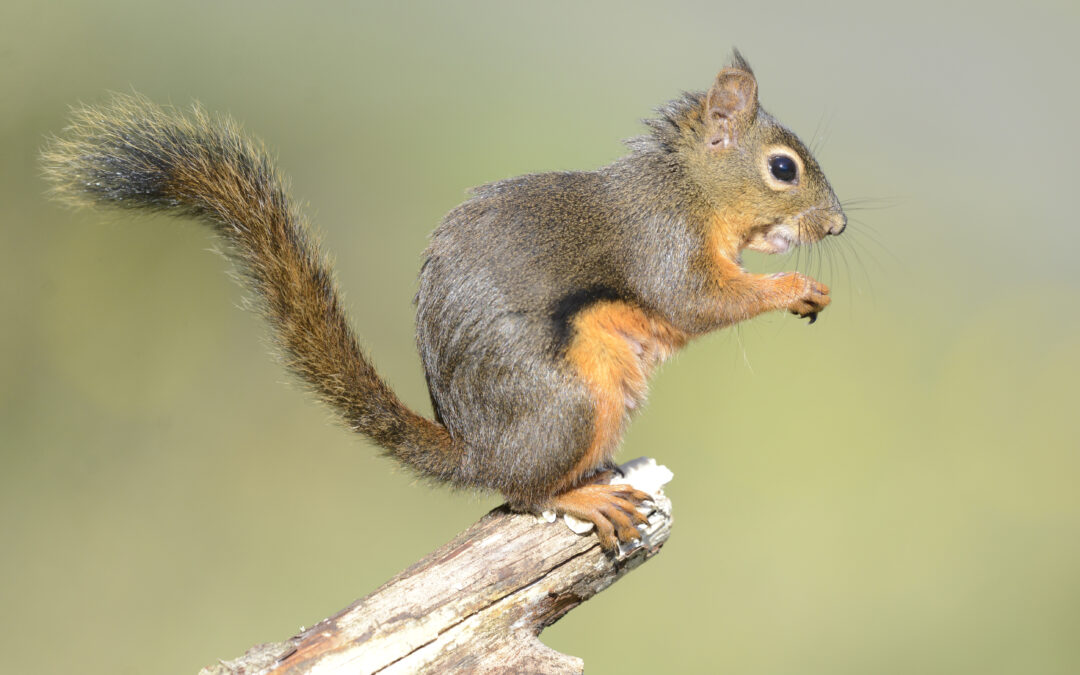Seven species of these fuzzy rodents call Washington home, but only five of them are native to our area. All live in forests, and are primarily herbivorous, but they are surprisingly diverse in their lifestyles and range. Top predators of most squirrels are domestic cats, bobcats, weasels, hawks, and owls.
The most common species in western Washington is Douglas squirrel (above). If you have spent any time in the woods, especially national parks, you’ve likely been scolded by one of them. In winter, they are reddish brown with tufted ears, small (about 13 inches or 33 centimeters long with the tail), and very territorial. Their preferred foods are the seeds within cones of conifers, including Douglas fir, Sitka spruce, and shore pine, and they also enjoy mushrooms, bird eggs, acorns, and berries. Douglas Squirrels can be found from southern British Columbia to northern California, west of the Cascades crest.
The American red squirrel is similar to Douglas, but is found throughout the northern and mountainous ranges of the United States, within Washington, primarily in the northeast corner of the state and in the Rocky Mountains. They are about the same size as Douglas squirrel, but may have lighter brown fur and a white belly. They are equally at home in deciduous and coniferous forests and are quite adaptable.
The Western gray squirrel is also native to Washington, but has been listed as endangered by the state. They are endemic to our Oregon white oak (aka Garry oak) prairies and woodlands. Most of our rare prairie habitat has been lost to development, and as a result, there are not many Western Grays left. Many people confuse them with the very common and much larger Eastern gray squirrel, common in cities. Our Western grays are silvery-gray with a white belly, and are very shy.
By contrast, Eastern gray squirrels are large and have a brownish tinge to their gray fur, especially on their head and tail. They outcompete our smaller native squirrels and can quickly become pests, raiding bird feeders and taking up residence in attics. This is why it’s likely you’ll see these squirrels in cities Fox squirrels are very large, and, like the Eastern Gray, they have been brought here from the east. They are the largest squirrel found in Washington, and may reach 27 inches (68.5 centimeters) long, including their tail! Because of their very large size and willingness to eat a variety of foods, they easily outcompete smaller, native squirrel species.
The most elusive native squirrel species is not often encountered because they are nocturnal. Light brown Northern flying squirrels live in older coniferous forests, and feed mostly on mushrooms and lichens, but they do occasionally eat bird eggs and berries. They don’t “fly”, exactly, but glide from tree to tree by stretching taut the flap of skin between their front and back legs, forming a parachute. They have large, black eyes to help them see at night. Owls are their main predator, and they are the primary prey species of the endangered Northern spotted owl. Recently, a new, smaller species was identified using DNA testing. The darker-colored Humboldt’s flying squirrel is found from northwest Washington (where it shares habitat with Northern Flying Squirrels) to southern California.



Recent Comments